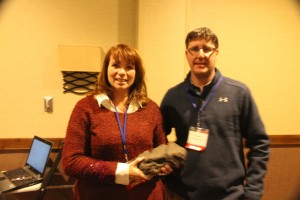
Jodi DeJong-Hughes holding “Clod-dette” with Terry Wehlander at the Conservation Tillage Conference.
Written by Jonathan Eisenthal
Conventional tillage has worked well in the Upper Midwest to address moderately excessive levels of early spring moisture, and to knock back weed pressure.
The problem is that tillage also destroys soil structure. Soil structure builds biological activity and favors plant growth, in turn building up the soil structure even more. That was the message experts gave to hundreds of farmers at the Conservation Tillage Conference held in Willmar in mid-December.
“Soil that holds together has pore spaces, and those pore spaces allow water infiltration, not to mention leaving roots the space that they love. They follow the path of least resistence. The pore spaces allow oxygen to get down there,” says Jodi DeJong-Hughes, a crops educator for University of Minnesota Extension Service. “Building your soil structure is my goal — and you do it by reducing your tillage. This is what builds your soil biology.”
She notes that while the added surface residue that comes with reduced tillage can keep soil at the surface cooler than naked black dirt, the pore spaces created by reduced tillage allow warm air to penetrate more deeply into the soil and bring the effect of solar radiation deeper into the soil profile.
DeJong-Hughes pointed out that in the current economic environment, which doesn’t favor farm operators making wholesale changes to their lineup of equipment, it’s still possible to reduce tillage in ways that will have a major impact on soil structure and biology.
Chisel plow points on a field cultivator can be adjusted to be less aggressive, according to DeJong-Hughes: “With proper adjustment, it can keep 50 percent of the residue on the field.”
Another fast and economical alternative is to convert a field cultivator or disk harrow into a vertical tillage machine. The true vertical coulter cuts a shallow path, straight up-and-down, from one to three inches deep in the soil. North Dakota farmer Terry Wehlander shared his experiences with making this change to a shallower, vertical tillage system, which he now uses on all his acres.
Wehlander described encountering the formation of a hardpan layer in his soil, so that the roots of his corn and soybean plants spread out in a shallow, horizontal fashion, rather than delving deep into the soil. To counteract the hardpan, Wehlander began using cover crops.
“Radishes are my chisel-plow and ripper,” Wehlander told the audience. “With reduced soil disturbance the dirt builds up aggregates. After three years of stable aggregates we started using tillage radishes, which have roots that go four feet deep in only six weeks growth.”
With the wet springs he was experiencing, Wehlander’s only hope of getting out in a timely way was vertical tillage. Because it doesn’t sink the tillage tool very deep, it’s not as apt to get mired in heavy, wet soil. The use of cover crops to help create pore spaces and soil structure also helped assure that tillage equipment could move freely across the field.
Even field cultivators can be set up for less aggressive tillage. DeJong-Hughes notes that cultivators turn the soil well and mix things evenly. However, farmers face the disadvantage that field cultivators leave less residue.
“A single pass can bring you down to 30 percent residue,” she says.
At one point, DeJong-Hughes held up “Clod-dette,” a clump of dirt the size of a football that she has had for a dozen years and keeps as evidence of the detrimental impact to the soil of deep tillage. In heavy clay soils she has seen farmers using deep tillage, turning up tombstone-size slabs of dirt, which are “impenetrable — very bad for root development.”
Wehlander cited research that shows conventional tillage can cause a farm field to lose a quarter-inch of soil every five years. He notes a host of benefits from going to vertical till, with the addition of cover crops.
“We’re managing our salinity much better, we’ve improved water infiltration, we’re seeing fuel savings and a drop in required maintenance,” says Wehlander. “When we started, our ground was more or less like a tarred road, but now we are building aggregates, the water drains, the salts are disappearing — and keep cover crops on their reduces it even more…the result has been better, more consistent crops. Our fields are evening out and our yields are going up. I got into this because I am trying to save my topsoil, my most precious commodity.”
The 2015 Conservation Tillage Conference, the largest gathering of its kind in the upper Midwest, is organized in a partnership between the extension services of University of Minnesota and North Dakota State University.

